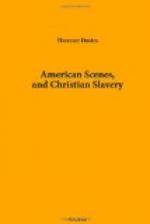We must, however, bid adieu to this “Queen of the West,” and pursue our course against the Ohio’s current towards Pittsburg. We steam along between freedom and slavery. The contrast is striking. On this subject the remarks of the keen and philosophic M. de Tocqueville are so accurate, and so much to the point, that I cannot do better than transcribe and endorse them.
“A century had scarcely elapsed since the foundation of the colonies, when the attention of the planters was struck by the extraordinary fact that the provinces which were comparatively destitute of slaves increased in population, in wealth, and in prosperity, more rapidly than those which contained the greatest number of negroes. In the former, however, the inhabitants were obliged to cultivate the soil themselves, or by hired labourers; in the latter, they were furnished with hands for which they paid no wages: yet, although labour and expense were on the one side, and ease with economy on the other, the former were in possession of the most advantageous system. * * * The more progress was made, the more was it shown that slavery, which is so cruel to the slave, is prejudicial to the master.
“But this truth was most satisfactorily demonstrated when civilization reached the banks of the Ohio. The stream which the Indians had distinguished by the name of Ohio, or Beautiful River, waters one of the most magnificent valleys which have ever been made the abode of man. Undulating lands extend upon both shores of the Ohio, whose soil affords inexhaustible treasures to the labourer. On either bank the air is wholesome and the climate mild; and each of those banks forms the extreme frontier of a vast State: that which follows the numerous windings of the Ohio on the left is Kentucky [in ascending the river it was on our right]; that on the right [our left] bearing the name of the river. These two States differ only in one respect,—Kentucky has admitted slavery, but the State of Ohio has not. * * *
“Upon the left bank of the stream the population is rare; from time to time one descries a troop of slaves loitering in the half-desert fields; the primeval forest recurs at every turn; society seems to be asleep, man to be idle, and nature alone offers a scene of activity and life.
“From the right bank, on the contrary, a confused hum is heard, which proclaims the presence of industry; the fields are covered with abundant harvests; the elegance of the dwellings announces the taste and activity of the labourer; and man appears to be in the enjoyment of that wealth and contentment which are the reward of labour.”
The Kentucky and the Ohio States are nearly equal as to their area in square miles. Kentucky was founded in 1775, and Ohio in 1788. In 1840 the population of Kentucky was 779,828, while that of Ohio was 1,519,467—nearly double that of the former. By this time it is far more than double.




